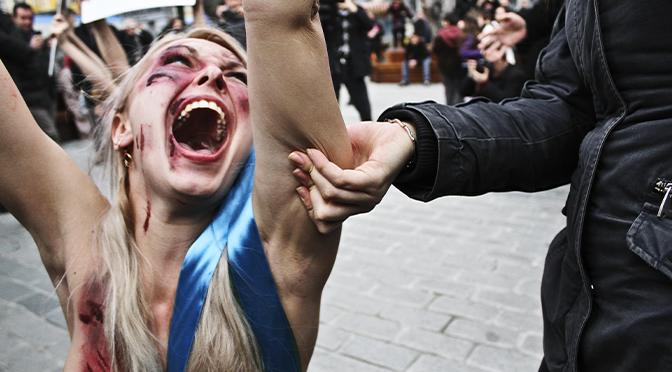On March 11, 2013, Tunisian Amina Sbouï published a bare-chested self-portrait on her Facebook page. “My body belongs to me and is not the source of anyone’s honor,” she had written on her naked torso. In doing so, she sparked a furious controversy in Islamic-led Tunisia. She received death threats. A Salafist preacher publicly called for 100 lashes and stoning for her. She later told a talk show that she had not gone topless for sexual reasons, but to call for women’s liberation.
Two years earlier, Egyptian blogger Aliaa Magda Elmahdy published photos of herself nude – except for red shoes and stockings without straps. For her, these photos were “cries against a society full of violence, racism, sexism, sexual harassment and hypocrisy.” She also received death threats, which forced her to go into hiding and eventually flee to Sweden.
Both women are activists in the FEMEN movement, which originated in Ukraine. “Sextremism” is what the women call their form of nonviolent resistance. Their main concern is the liberation of women from sexism and patriarchy. Nudity is their typical means of protest.
At first, their goals were regionally limited. In their first phase in 2008-2011, they were concerned with Ukrainian women’s rights, economic and political issues such as sex tourism, poverty, unequal access to jobs and higher education, and women’s lack of participation in the Ukrainian government and leadership positions. Their bare breasts were often painted in Ukraine’s colors.
After 2011, more and more media covered the FEMEN actions and their ideas found global supporters and fellow activists. Using their naked bodies as an active tool to oppose patriarchy was a completely new approach to using the sexist weapons of patriarchy against themselves. Playing with the stereotypical codes became the way to make absurd the male ideas about the nature of female sexuality.
Nudity in public is a step to break out of the patriarchal structures that try to define and control the female body. The body thus becomes a non-violent weapon, a site and mechanism of protest.
In her own words, “FEMEN’s naked attacks are the naked nerve of the historical conflict between woman and system, its most visual and appropriate illustration. The activist’s naked body is the unconcealed hatred of the patriarchal order and the new aesthetics of the women’s revolution.”

